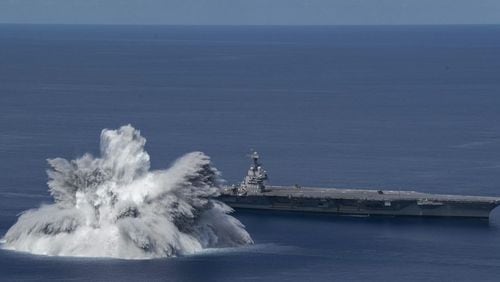The U.S. Navy’s newest aircraft carrier can withstand quite a wallop.
On Friday, the USS Gerald R. Ford (CVN-78) blasted thousands of pounds of explosives in the Atlantic Ocean to simulate how the ship would perform in battle conditions. The blast was equivalent to a 3.9 magnitude earthquake, according to images released by the service and government earthquake monitors.
The carrier was wired with sensors to measure the effects of the shock. The ship was hit with the blast about 100 miles off the Florida coast just before 4 p.m.
“The first-in-class aircraft carrier was designed using advanced computer modeling methods, testing, and analysis to ensure the ship is hardened to withstand battle conditions, and these shock trials provide data used in validating the shock hardness of the ship,” the Navy said Saturday.
Ford commanding officer Capt. Paul Lanzilotta told USNI News in March aboard the carrier that the crew had been busy preparing for the event.
“That’s quite a bit of work when you have a ship with 5,000 spaces in it, so we have to prepare all of our gear,” he said. ”We’re also going to prepare the crew: so the crew has to know what to expect, they need to practice their damage control procedures because that’s something that we all need to be good at, and when we shock the ship we need to make sure that we have the ship in as ready a condition as we can.”







